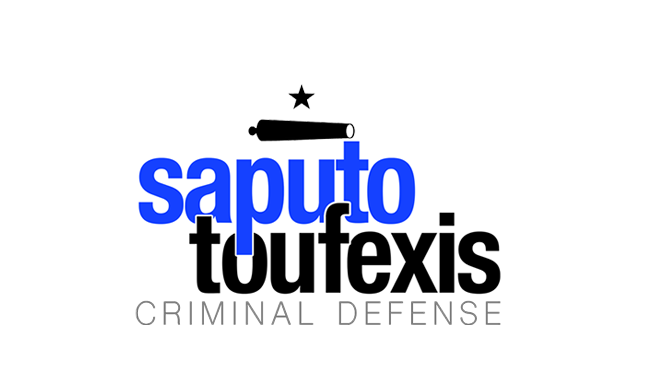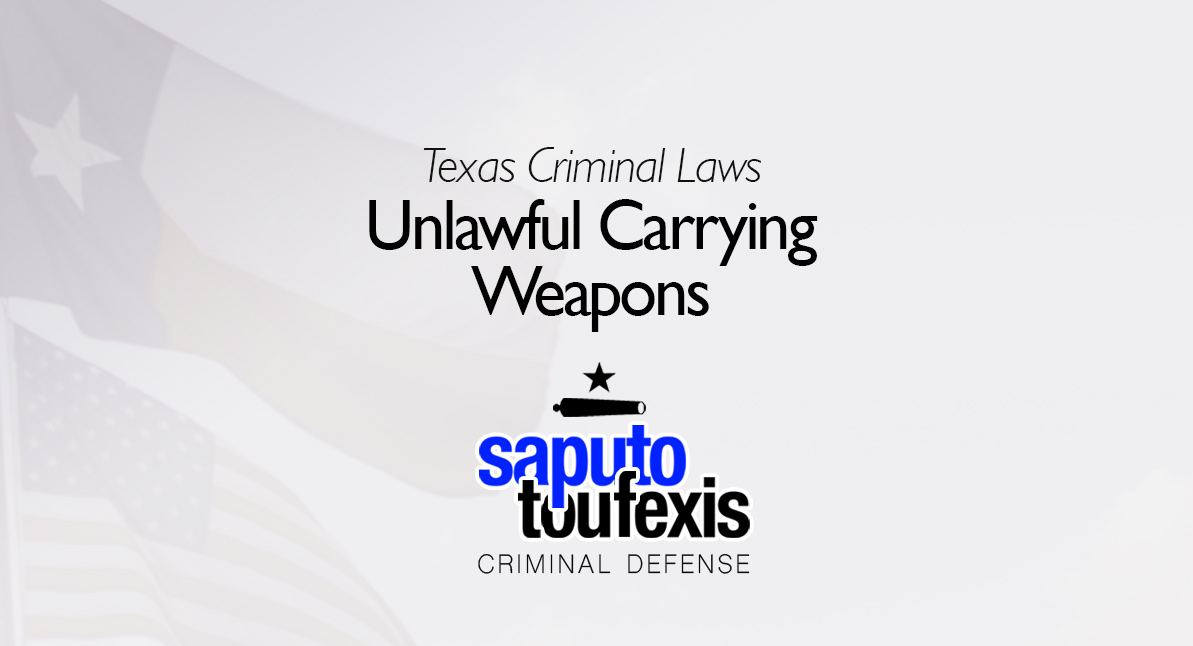The Texas Unlawful Carrying Weapons law, also known as “UCW” in Texas, makes it illegal for certain people to carry handguns and other weapons under the circumstances described in detail in the statute, including possessing a handgun if you’re under 21 and carrying a handgun in your vehicle if you’re engaged in criminal activity.
FAQs about the
Unlawful Carrying Weapons (“UCW”) law in Texas
- What is the current Texas law about UCW?
- What is the penalty for a Texas Unlawful Carrying Weapons (“UCW”) offense?
- What changed in 2021? What is constitutional carry?
- What changed in 2019?
- Who is exempt from the Unlawful Carrying Weapons law?
- How does UCW interact with my LTC (formerly CHL) or LTC (formerly CHL)?
- How did the UCW law change when Texas passed the Open Carry Laws?
- Can I get deferred for UCW? Is there a waiting period for nondisclosure? What are the laws about UCW probation?
- Can I get an expunction for a UCW?
- Can you get probation for Unlawful Carrying Weapons (“UCW”) in Texas?
- What level of crime is Unlawful Carrying Weapons (“UCW”) in Texas?
The Texas legislature codified this criminal offense in Texas Penal Code Section 46.02. The law was not amended in 2025. The law was most recently amended in 2021 with the passage of the “constitutional carry” law. This new law provided that people over 21 years old are generally able to carry a handgun outside of their home or vehicle without any permit. The UCW law was very different before September 1, 2021. So if you have been arrested for an offense that occurred before September 1, 2021, you need to examine the law as it existed on the date of the offense. We explore the UCW law and how it has changed in more detail below.
Have you been charged with Unlawful Carrying Weapons (“UCW”)? Contact us today to discuss legal representation.
or Text or Call (888) 239-9305
The current UCW law (effective as of September 1, 2021) makes it illegal to carry a handgun outside of your home or vehicle (unless you’re directly en route to and from those locations) if you’re: (1) intoxicated (with exceptions), (2) prohibited from possessing a firearm under other law, (3) under 21 years old, or (4) convicted of certain offenses within five years from the date of carry. The current law also makes it illegal: (1) to carry a handgun in plain view in a public place unless the handgun is in a holster, (2) to carry a handgun in plain view inside a vehicle unless you’re 21 (or if you’re permitted) and the handgun is in a holster.
The UCW law also prohibits people under 18 years old from possessing “location-restricted” knives outside of their homes unless they’re under adult supervision.
The Unlawful Carrying Weapons offense is different from the Unlawful Possession of a Firearm offense.
The Penal Code classifies the Texas Unlawful Carrying Weapons (“UCW”) law under Title 10 “Offenses Against Public Health, Safety, and Morals,” Chapter 46 “Weapons.” Learn more about the Texas offense of Unlawful Carrying Weapons (“UCW”) below.
What is the current Texas law about UCW?
The Texas UCW law is codified at Texas Penal Code Section 46.02.[1] It is divided into six parts, each part with its own subsection. Each subsection describes a different way to violate the law: subsections (a), (a-1), (a-4), (a-5), (a-6), and (a-7).
The first subsection, subsection (a), came into its final form as part of the amendments that were made to accommodate “constitutional carry.” Subsection (a) currently prohibits people under 21 from possessing handguns outside of their home and vehicles, in addition to people who have certain convictions as follows:
(a) A person commits an offense if the person:
(1) intentionally, knowingly, or recklessly carries on or about his or her person a handgun;
(2) at the time of the offense:
(A) is younger than 21 years of age; or
(B) has been convicted of an offense under Section 22.01(a)(1), 22.05, 22.07, or 42.01(a)(7) or (8) committed in the five-year period preceding the date the instant offense was committed; and
(3) is not:
(A) on the person’s own premises or premises under the person’s control; or
(B) inside of or directly en route to a motor vehicle or watercraft that is owned by the person or under the person’s control.
Subsection (a-1) of the UCW lawprohibits having a handgun in “plain view” in your motor vehicle unless you are 21 or older or are licensed, and the handgun is in a holster. It also prohibits carrying in a vehicle if you’re engaged in “criminal activity” (other than Class-C traffic/boating) or prohibited from possessing a firearm.
(a-1) A person commits an offense if the person intentionally, knowingly, or recklessly carries on or about his or her person a handgun in a motor vehicle or watercraft that is owned by the person or under the person’s control at any time in which:
(1) the handgun is in plain view, unless the person is 21 years of age or older or is licensed to carry a handgun under Subchapter H, Chapter 411, Government Code, and the handgun is carried in a holster; or
(2) the person is:
(A) engaged in criminal activity, other than a Class C misdemeanor that is a violation of a law or ordinance regulating traffic or boating; or
(B) prohibited by law from possessing a firearm.
Subsection (a-4) of the UCW law covers location-restricted knives.
(a-4) A person commits an offense if the person:
(1) intentionally, knowingly, or recklessly carries on or about his or her person a location-restricted knife;
(2) is younger than 18 years of age at the time of the offense; and
(3) is not:
(A) on the person’s own premises or premises under the person’s control;
(B) inside of or directly en route to a motor vehicle or watercraft that is owned by the person or under the person’s control; or
(C) under the direct supervision of a parent or legal guardian of the person.
Subsection (a-5) of the UCW law covers carrying a handgun in plain view in a public place.
(a-5) A person commits an offense if the person carries a handgun and intentionally displays the handgun in plain view of another person in a public place. It is an exception to the application of this subsection that the handgun was partially or wholly visible but was carried in a holster.
Subsection (a-6) of the UCW law covers carrying a handgun while intoxicated.
(a-6) A person commits an offense if the person:
(1) carries a handgun while the person is intoxicated; and
(2) is not:
(A) on the person’s own property or property under the person’s control or on private property with the consent of the owner of the property; or
(B) inside of or directly en route to a motor vehicle or watercraft: (i) that is owned by the person or under the person’s control; or (ii) with the consent of the owner or operator of the vehicle or watercraft.
Subsection (a-7) of the UCW law covers people prohibited from possessing a firearm under the Unlawful Possession of a Firearm law in Texas.
(a-7) A person commits an offense if the person:
(1) intentionally, knowingly, or recklessly carries on or about his or her person a handgun;
(2) is not:
(A) on the person’s own premises or premises under the person’s control; or
(B) inside of or directly en route to a motor vehicle or watercraft that is owned by the person or under the person’s control; and
(3) at the time of the offense, was prohibited from possessing a firearm under Section 46.04(a), (b), or (c).
What is a “criminal street gang“?
The UCW law mentions the term “criminal street gang.” The criminal street gang definition is discussed in our article about Engaging in Organized Criminal Activity. The criminal street gang provisions were removed from the UCW offense in the 87th Legislature, effective September 1, 2021.
What is the penalty for a Texas Unlawful Carrying Weapons (“UCW”) offense?
Under the current law, the UCW offense is punished as a Class A Misdemeanor[2] unless it’s an (a-4) offense (the “location-restricted knife” offense – as described above), in which case it is a Class C Misdemeanor,[3] or it’s an (a-7) offense, in which case it can be either a second or third degree felony.[4]
In addition, prosecutors may seek a one-classification level enhancement for Chapter 46 offenses under the Weapon-Free School Zone Law by proving beyond a reasonable doubt that you committed the offense in a place that you knew was within 300 feet of the premises of a school or at an official school function or game.[5]
What changed in 2021? What is constitutional carry?
As briefly described above, in 2021 the 87th Texas Legislature significantly amended the UCW law.[6] Perhaps most notably, an exception was created to the general prohibition against carrying a handgun. The exception allows people over 21 years old to carry a handgun outside of their home or vehicle so long as within 5 years of the date of carry they have not been convicted of Assault Bodily Injury (not Class C Assault), Deadly Conduct, Terroristic Threat, Disorderly Conduct subsection (a)(7) – discharging a firearm in a public place, or Disorderly Conduct subsection (a)(8) – displaying a firearm in a manner calculated to alarm.
The exception regarding carrying in, to, and from your home or vehicle does still apply to the people under 21 and those convicted of the offenses described above. So if you are under 21 years old, you can still carry a handgun to your home from your vehicle and vice versa. However, there are still other situations in which it is illegal to carry a handgun.
The legislature also changed subsection (a-1) by providing that the “plain view” rule that prohibits carrying a handgun in plain view in a motor vehicle only applies to people who are under 21 years old, unless the 21-year-old has a license, so long as the handgun is in a holster. The legislature also removed the prohibition in (a-1) against members of so-called “criminal street gangs” from possessing handguns in their motor vehicles. What is a “criminal street gang“?
The legislature then added subsections (a-5), (a-6), (a-7), and (a-8). Subsection (a-5) makes it illegal to intentionally carry a handgun in plain view in a public place unless the handgun is in a holster. Subsection (a-6) makes it illegal to carry a handgun while intoxicated unless you’re in your own property or property that you have consent to be in, inside of or on your way to your own vehicle or a vehicle which you have consent to be in. Subsection (a-7) makes it illegal to possess a handgun outside of your home or vehicle if you’re prohibited from possessing a firearm under the Unlawful Possession of Firearm law (unless the unlawful possession was because of membership in a criminal street gang.
Jump back to the current Texas UCW law
Subsection (a-8) allows people in violation of subsection (a-7) to be prosecuted under (a-7) or Unlawful Possession of a Firearm or other similar law.
The punishment provisions were updated to reflect that UCW violations of (a-7) would be either second or third degree felonies. If the person was prohibited from possessing a firearm because of a felony conviction, the (a-7) violation is punished as a second-degree felony with a minimum 5-year punishment. Otherwise, (a-7) violations are punished as third-degree felonies.
What changed in 2019?
In 2019, the 86th Texas Legislature removed “clubs” from the UCW offense.[7]
More Statutory History – 2017 and Prior Versions of the UCW Law
In HB 1935, the 85th Texas Legislature amended the UCW law with the passage of HB 1935 by (1) removing “illegal knives” from regulation under the UCW law and (2) creating a new subsection (a-4) that regulates the possession of “Location-restricted knives” by juveniles and set the offense level for this new subsection as a Class C misdemeanor.[8]
The law in effect for offenses occurring on or after September 1, 2017, but before September 1, 2019, is below (language removed from the 2015 version of the law is indicated in strikethrough):
(a) A person commits an offense if the person:
(1) intentionally, knowingly, or recklessly carries on or about his or her person a handgun
, illegal knife,or club; and(2)
if the personis not:(A) on the person’s own premises or premises under the person’s control; or
(B) inside of or directly en route to a motor vehicle or watercraft that is owned by the person or under the person’s control.
(a-1) A person commits an offense if the person intentionally, knowingly, or recklessly carries on or about his or her person a handgun in a motor vehicle or watercraft that is owned by the person or under the person’s control at any time in which:
(1) the handgun is in plain view, unless the person is licensed to carry a handgun under Subchapter H, Chapter 411, Government Code, and the handgun is carried in a shoulder or belt holster; or
(2) the person is:
(A) engaged in criminal activity, other than a Class C misdemeanor that is a violation of a law or ordinance regulating traffic or boating;
(B) prohibited by law from possessing a firearm; or
(C) a member of a criminal street gang, as defined by Section 71.01.
Subsections (a-2) and (a-3) only contain definitions of “premises” “recreational vehicle” and “watercraft.”
(a-4) A person commits an offense if the person:
(1) intentionally, knowingly, or recklessly carries on or about his or her person a location-restricted knife;
(2) is younger than 18 years of age at the time of the offense; and
(3) is not:
(A) on the person’s own premises or premises under the person’s control;
(B) inside of or directly en route to a motor vehicle or watercraft that is owned by the person or under the person’s control; or
(C) under the direct supervision of a parent or legal guardian of the person.
In 2015, the Texas legislature passed the “open carry” laws that allowed license holders to carry openly in a holster.[9] After the passage of the open carry laws, the UCW law in effect for offenses occurring before September 1, 2017 was as follows (the phrase in bold below was added by the legislature in 2015):
(a) A person commits an offense if the person intentionally, knowingly, or recklessly carries on or about his or her person a handgun, illegal knife, or club if the person is not:
(1) on the person’s own premises or premises under the person’s control; or
(2) inside of or directly en route to a motor vehicle or watercraft that is owned by the person or under the person’s control.
(a-1) A person commits an offense if the person intentionally, knowingly, or recklessly carries on or about his or her person a handgun in a motor vehicle or watercraft that is owned by the person or under the person’s control at any time in which:
(1) the handgun is in plain view, unless the person is licensed to carry a handgun under Subchapter H, Chapter 411, Government Code, and the handgun is carried in a shoulder or belt holster; or
(2) the person is:
(A) engaged in criminal activity, other than a Class C misdemeanor that is a violation of a law or ordinance regulating traffic or boating;
(B) prohibited by law from possessing a firearm; or
(C) a member of a criminal street gang, as defined by Section 71.01.
Who is exempt from the Unlawful Carrying Weapons law?
Under the current law, Texas Penal Code Section 46.15 exempts many people from the applicability of both the current and prior versions of the UCW law.[10] This “Nonapplicability” statute has undergone significant changes in each legislative session since 2005. Five separate bills were passed in the 2021 legislative session that changed this law, effective September 1, 2021: HB 2112, SB 550, HB 1927, HB 3607 and HB 1069.
Section 46.15(a) of the Texas Penal Code exempts law enforcement and court officials and even some volunteer emergency personnel,[11] and Section 46.15(b) exempts certain military members, people who are traveling, hunters and fishermen, security officers, personal protection officers, LTC (formerly CHL) holders, alcoholic beverage permit holders, and law enforcement students under certain circumstances.[12]
In addition, Texas law contains the following exemptions:
Section 46.15(c) exempts a properly trained “noncommissioned security guard at an institution of higher education who carries a nightstick or similar club”(this subsection was repealed by HB 446, 86th Texas Legislature, effective September 1, 2019 because “clubs” were removed from the UCW offense by the same bill, so the exemption was no longer necessary).- Section 46.15(d) exempts a “public security officer employed by the adjutant general” from prohibitions on the carrying of a firearm
or a club(the club exemption was repealed by HB 446, 86th Texas Legislature, effective September 1, 2019 because “clubs” were removed from the UCW offense by the same bill, so the exemption was no longer necessary) - Section 46.15(e) exempts the carrying of a bowie knife or sword in a “historical demonstration or in a ceremony” (and beginning September 1, 2017, pursuant to HB 1935, this exemption will be extended to all location-restricted knives)
- Section 46.15(j) exempts people who carry a handgun in a “historical reenactment performed in accordance with the rules of the Texas Alcoholic Beverage Commission”
How does UCW interact with my LTC (formerly CHL) or LTC (formerly CHL)?
Under Section 46.15(b)(6), the Unlawful Carrying Weapons offense does not apply to holders of a LTC (formerly CHL), whether the weapon was concealed or, under the new Open Carry law passed in 2017, carried openly in a shoulder or belt holster (the words shoulder or belt were deleted in the 87th Legislature). If you are charged with UCW and you hold a LTC (formerly CHL) permit, immediately inform your criminal defense attorney. You may be able to get your UCW case dismissed.
Note, however, that Section 46.035 contained separate rules for prohibited carry by LTC (formerly CHL) holders, but this law was repealed in 2021 by HB 1927. Section 46.035 covered the conspicuous carry of handguns and carrying a handgun at a bar, church, sporting event, amusement park and other places. It also covered carrying a handgun while intoxicated and carrying at a government meeting. Also note that your LTC (formerly CHL) can be suspended if you are convicted of certain misdemeanor and felony offenses.
How did the UCW law change when Texas passed the Open Carry Laws?

In 2015, the UCW law changed significantly when Texas passed the new Open Carry laws. In summary, the open carry law made it no longer a crime for a LTC (formerly CHL or CCL – that is, a holder of a concealed carry permit) to carry a handgun in a shoulder or belt holster in plain view, under most circumstances. Of course, there are still some places where weapons are not allowed. Also, under the 2021 law changes, it no longer is necessary to have a permit to carry openly so long as the handgun is in a holster (unless one of the other UCW subsections apply).
How did the UCW statute change to make open carry legal? First, House Bill 910 amended subsection (a-1)(1) of the UCW law by adding “unless the person is licensed to carry a handgun under Subchapter H, Chapter 411, Government Code, and the handgun is carried in a shoulder or belt holster” as an exception to the “plain view” type of UCW violation.[13] In amendments passed in later legislative sessions, the legislature added an additional exemption for people over 21 years old.
Globally, the same House Bill eliminated the word “concealed” from various places in the Penal Code (including Section 46.15) because, essentially, a “concealed” handgun permit now allows people to carry in a concealed and un-concealed manner. So the exceptions that applied to concealed handguns now generally apply to both concealed and visible handguns.
The change is effective only to offenses committed after the effective date of the bill,[14] January 1, 2016.[15]
Can I get deferred for UCW? Is there a waiting period for nondisclosure? What are the laws about UCW probation?
UCW charges are eligible to be deferred under Article 42A.102 of the Texas Code of Criminal Procedure. Straight probation is also allowed to be imposed by both the judge and jury.[16] However, Sec. 411.073 of the Texas Government Code mandates a 2 year waiting period to petition the court for an order of nondisclosure after the successful completion of deferred adjudication probation.
Can I get an expunction for a UCW?
In 2021, the 87th Legislature changed Chapter 55 of the Texas Code of Criminal Procedure to allow people who have been convicted of a Subsection (a) violation of the UCW law to receive an expunction.[17] This is, unfortunately, a narrow category of UCW violations. It covers prosecutions for carrying a weapon outside of your home or vehicle without a permit, but it will not cover prosecutions for UCW based on the motor-vehicle related offenses, such as carrying a weapon in a vehicle while you committed another offense or while being a member of a criminal street gang.
Learn more about UCW expunctions
Can you get probation for Unlawful Carrying Weapons (“UCW”) in Texas?
The Texas Code of Criminal Procedure allows both judges and juries to grant probation for Unlawful Carrying Weapons (“UCW”), and judges are also allowed to accept deferred adjudication plea deals.[18]
Note, however, that no matter the offense, neither judges nor juries may recommend community supervision for any suspended sentence of over 10 years.[19] Also, judges may not grant community supervision after a conviction if (1) the defendant used or exhibited a deadly weapon during the commission of the felony or immediate flight thereafter and (2) the defendant used or exhibited the deadly weapon himself or was a party to the offense and knew that a deadly weapon would be used or exhibited.[20]
What level of crime is Unlawful Carrying Weapons (“UCW”) in Texas?
The Penal Code classifies Unlawful Carrying Weapons (“UCW”) as a Class C misdemeanor, Class A misdemeanor, a third degree felony, or a second degree felony, depending on the circumstances.
Learn more about the penalty range for this offense in the section above.
Legal References:
^1. Texas Penal Code §46.02^2. Texas Penal Code §46.02(b)^3. Texas Penal Code §46.02(d)^4. Texas Penal Code §46.02(e)^5. §46.11, Texas Penal Code^6. HB 1927, 87th Texas Legislature, Section 22, effective September 1, 2021^7. HB 446, 86th Texas Legislature, Section 1, effective September 1, 2019^8. HB 1935, 85th Texas Legislature, Section 4, effective September 1, 2017^9. HB 910, 84th Texas Legislature, Section 45, effective September 1, 2015^10. Texas Penal Code §46.15^11. Texas Penal Code §46.15(a)
Sections 46.02 and 46.03 do not apply to:
(1) peace officers or special investigators under Article 2A.002, Code of Criminal Procedure, and neither section prohibits a peace officer or special investigator from carrying a weapon in this state, including in an establishment in this state serving the public, regardless of whether the peace officer or special investigator is engaged in the actual discharge of the officer’s or investigator’s duties while carrying the weapon;
(2) parole officers and neither section prohibits an officer from carrying a weapon in this state if the officer is:
(A) engaged in the actual discharge of the officer’s duties while carrying the weapon; and
(B) in compliance with policies and procedures adopted by the Texas Department of Criminal Justice regarding the possession of a weapon by an officer while on duty;
(3) community supervision and corrections department officers appointed or employed under Section 76.004, Government Code, and neither section prohibits an officer from carrying a weapon in this state if the officer is:
(A) engaged in the actual discharge of the officer’s duties while carrying the weapon; and
(B) authorized to carry a weapon under Section 76.0051, Government Code;
(4) an active judicial officer as defined by Section 411.201, Government Code, who is licensed to carry a handgun under Subchapter H, Chapter 411, Government Code;
(5) an honorably retired peace officer, qualified retired law enforcement officer, federal criminal investigator, or former reserve law enforcement officer who holds a certificate of proficiency issued under Section 1701.357, Occupations Code, and is carrying a photo identification that is issued by a federal, state, or local law enforcement agency, as applicable, and that verifies that the officer is:
(A) an honorably retired peace officer;
(B) a qualified retired law enforcement officer;
(C) a federal criminal investigator; or
(D) a former reserve law enforcement officer who has served in that capacity not less than a total of 15 years with one or more state or local law enforcement agencies;
(6) a district attorney, criminal district attorney, county attorney, or municipal attorney who is licensed to carry a handgun under Subchapter H, Chapter 411, Government Code;
(7) an assistant district attorney, assistant criminal district attorney, or assistant county attorney who is licensed to carry a handgun under Subchapter H, Chapter 411, Government Code;
(8) a bailiff designated by an active judicial officer as defined by Section 411.201, Government Code, who is:
(A) licensed to carry a handgun under Subchapter H, Chapter 411, Government Code; and
(B) engaged in escorting the judicial officer; or
(9) a juvenile probation officer who is authorized to carry a firearm under Section 142.006, Human Resources Code.
^12. Texas Penal Code §46.15(b)(1)
(b) Section 46.02 does not apply to a person who:
(1) is in the actual discharge of official duties as a member of the armed forces or state military forces as defined by Section 437.001, Government Code, or as a guard employed by a penal institution;
(2) is traveling;
(3) is engaging in lawful hunting, fishing, or other sporting activity on the immediate premises where the activity is conducted, or is en route between the premises and the actor’s residence, motor vehicle, or watercraft, if the weapon is a type commonly used in the activity;
(4) holds a security officer commission issued by the Texas Private Security Board, if the person is engaged in the performance of the person’s duties as an officer commissioned under Chapter 1702, Occupations Code, or is traveling to or from the person’s place of assignment and is wearing the officer’s uniform and carrying the officer’s weapon in plain view;
(5) acts as a personal protection officer and carries the person’s security officer commission and personal protection officer authorization, if the person:
(A) is engaged in the performance of the person’s duties as a personal protection officer under Chapter 1702, Occupations Code, or is traveling to or from the person’s place of assignment; and
(B) is either:
(i) wearing the uniform of a security officer, including any uniform or apparel described by Section 1702.323(d), Occupations Code, and carrying the officer’s weapon in plain view; or
(ii) not wearing the uniform of a security officer and carrying the officer’s weapon in a concealed manner;
(6) is carrying:
(A) a license issued under Subchapter H, Chapter 411, Government Code, to carry a handgun; and
(B) a handgun:
(i) in a concealed manner; or
(ii) in a shoulder or belt holster;a concealed handgun and a valid license issued under Subchapter H, Chapter 411, Government Code, to carry a concealed handgun;
(7) holds an alcoholic beverage permit or license or is an employee of a holder of an alcoholic beverage permit or license if the person is supervising the operation of the permitted or licensed premises;
(8) is a student in a law enforcement class engaging in an activity required as part of the class, if the weapon is a type commonly used in the activity and the person is:
(A) on the immediate premises where the activity is conducted; or
(B) en route between those premises and the person’s residence and is carrying the weapon unloaded.
^13. HB 910, 84th Texas Legislature (RS), Section 45, effective January 1, 2016^14. HB 910, 84th Texas Legislature (RS), Section 51, effective January 1, 2016^15. HB 910, 84th Texas Legislature (RS), Section 53, effective January 1, 2016^16. Texas Code of Criminal Procedure Chapter 42A^17. HB 1927, 87th Texas Legislature, Section 4^18. See Chapter 42A, Texas Code of Criminal Procedure, Art. 42A.054, Art. 42A.056, Art. 42A.102^19. Art. 42A.053(c), Texas Code of Criminal Procedure^20. Art. 42A.054(b), Texas Code of Criminal Procedure










